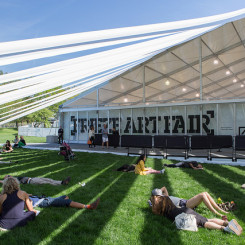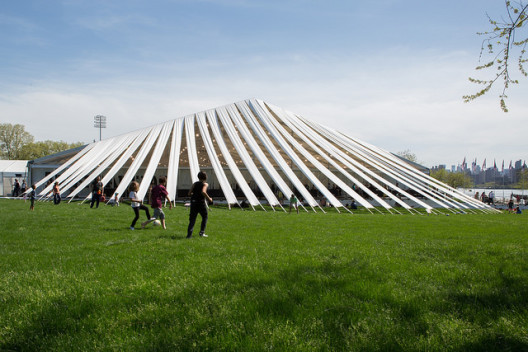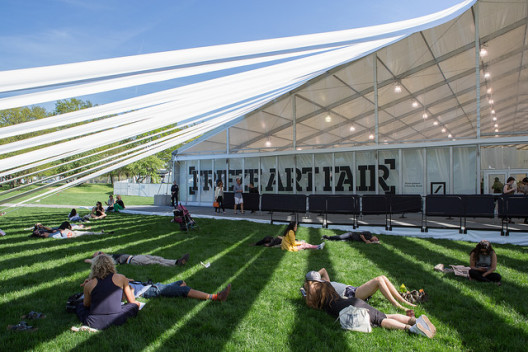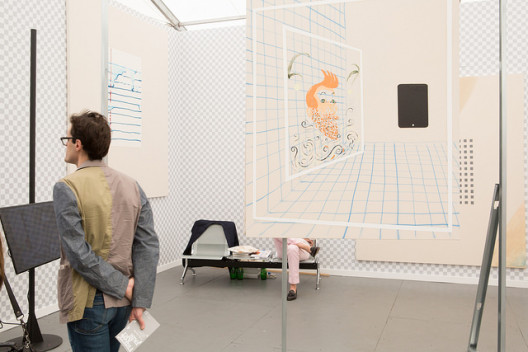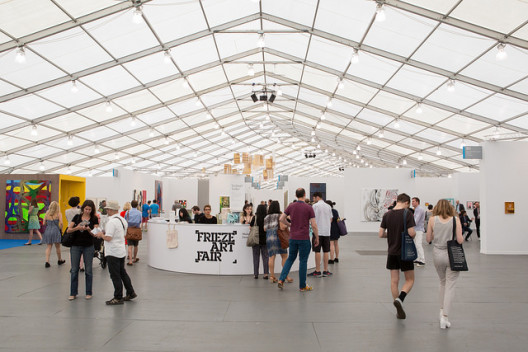Frieze has established itself as the freshest major art fair—a condensation of both youthful (among them Antenna Space, Clearing and Kraupa-Tuskany Zeidler) and blue chip (Gagosian, White Cube, Hauser and Wirth et al) contemporary galleries in a fashionable, un-stuffy atmosphere. Here, you can find barely dry paint from artists who may not have had their first solo show (see the “Frame” and “Focus” sections for emerging artists and galleries). While attitudes to Frieze Art Fair in London—where it began eleven years ago—can come across as somewhat jaded (its longevity there and changes in the market have contributed to a more conservative feel), in New York, which this week sees its fourth edition of the fair, one senses more pure expectations. This attitude was palpable in March at the Armory show, New York’s local fair, where many participating galleries were already gazing beyond their booths to Frieze; some admitted to having saved the best works for it. That said, these expectations must be met and maintained by organizers and galleries alike for this stateside branch of the fair—last year’s edition did not pass without some criticism for slightly repetitive or safe displays and overcrowding by both visitors and works.
Despite being the only art fair with “fair” in its title, the organizers claim for Frieze more democratic reach; the ambition to reach multiple audiences and encourage casual visitors as well as buyers is clear from the presentation, for instance with a book shop in the tent and energetic projects and installations—often outdoors. Visitor numbers swell annually. Frieze also sports the best selection of in-show eateries of any of the major fairs, with menus reflecting the spirit of local dining as well as the fair’s progressive cachet (new on the list is the hip downtown café Morgenstern’s which, we are promised, “will serve some of the city’s most original and contemporary ice creams”). An egalitarian attitude has been forced also into Frieze’s labor practices following condemnation from local unions about preceding editions in New York. In what was seen as an elitist imposition of the site on Randall’s Island (the bespoke tent purports to be the world’s largest at a quarter of a mile long, and commands a high entrance fee for visitors to a rarefied trade show staffed largely by non-locals), complaints arose about disregard for socio-economic equality. Frieze is now wholly contracted, for this and next year’s editions, to use local union labor for its event.
Facilitated by this staff will be 198 galleries, a slim increase on last year’s tally. Added to the show this year is a section called “Spotlight” for solo presentations of more historical work—these, we are told, will lean towards work by female artists living outside the Europe and the US in the 1960s and 70s. The commissioned projects this year are curated by the High Line Art Director and curator Cecilia Alemani; these are massage chairs from Korakrit Arunanondchai, “habitable paintings” from Pia Camil, from Samara Golden, a room beneath the tent which somehow reveals the structure of the fair, personality tests from Aki Sasamoto, an outdoor collapsed structure by Allyson Vieira and, made by the fair itself, a tribute to the “Flux-Labyrinth” made by the Fluxus group of artists in 1976. The Sounds section will contain three works which incorporate archival and collage elements – the artists are Alicja Kwade, Sergei Tcherepnin and Xaviera Simmons. There will be four galleries in attendance from China: Antenna Space and Leo Xu Projects (both from Shanghai) and, from Beijing, Boers-Li Gallery and Long March Space.
Alongside Frieze, a number of satellite fairs take place in the same week, some of which have real traction. NADA (The New Art Dealers Alliance, a non-profit organization), in particular, is an artist-centric fair worth seeing. The Outsider Art Fair has also been drawing attention with, as one might deduce from its title, artists and works from off-the-beaten art track (this year, many hail from New Zealand). New this year is the 1:54 Contemporary African Art Fair, and – occupying the Armory spot on Pier 94 – Art Miami New York. One might also seek out the Select art fair and Salon Zürcher.
In Frieze week, whether buying, selling or just looking, the challenge remains to find a balance between active exploration and a certain lenient selectiveness—as it was once said, “Too much art is, of course, as great an obstacle as too little art.” In this, perhaps, all are rendered equal.

